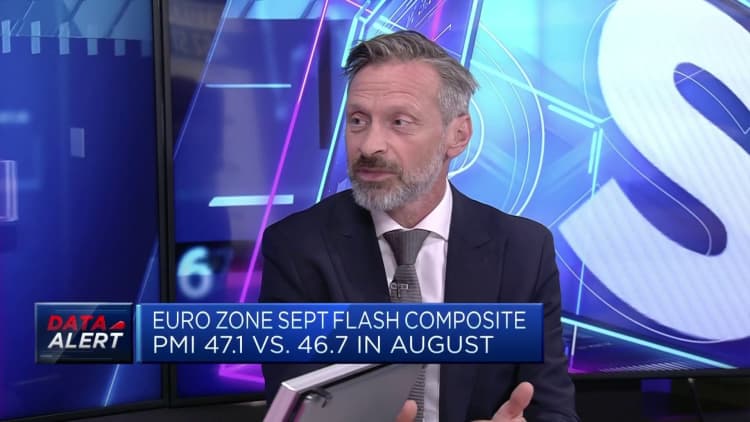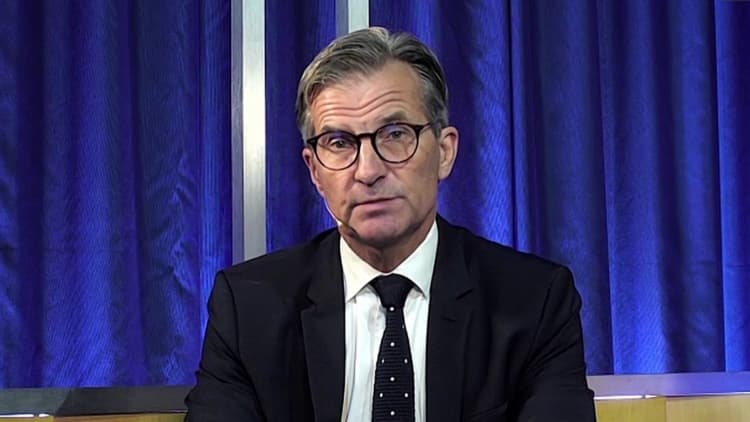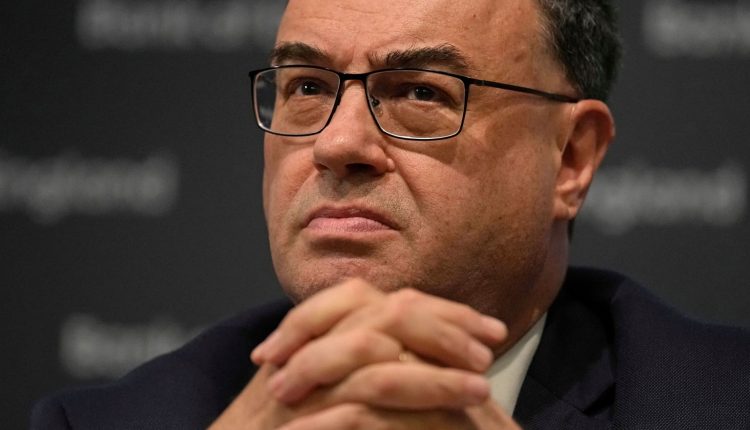Governor of the Bank of England Andrew Bailey attends the Monetary Policy Report press conference at the Bank of England, in London, on August 3, 2023. The Bank of England on Thursday hiked its key interest rate for a 14th time in a row, by a quarter-point to 5.25 percent as UK inflation stays high. Policymakers “will continue to monitor closely indications of persistent inflationary pressures”, the BoE said in a statement following a regular meeting. (Photo by Alastair Grant / POOL / AFP) (Photo by ALASTAIR GRANT/POOL/AFP via Getty Images)
Alastair Grant | Afp | Getty Images
High inflation continues to plague European households and businesses, and central banks in the region have yet to declare victory on bringing it to target.
But September marked a change in tone in their messaging, as some central banks put the breaks on interest rate hikes after nearly two years, while others appeared to be at the brink of peak rates. This has turned market attention to how long rates will be held at current levels, amid strains on economic growth.
This month’s decisions have shown “all central banks are coping with the same triple dilemma: how to balance between slowing economies, still too high inflation and the delayed impact of unprecedented rate hikes,” Carsten Brzeski, global head of macro at Dutch bank ING, told CNBC.
“The other common theme is, of course, that in all regions interest rates are very close to peak, which complicates the above described dilemma.”
The recent surge in oil prices poses an additional headache, he added, potentially fuelling inflation while dragging on economic growth — and making future interest rate decisions even more difficult to call.
U.K. pause
The Bank of England opted to pause interest rate moves after 14 straight hikes, keeping its main policy rate at 5.25%.
It was a close call, with five Monetary Policy Committee members voting to hold and four in favor of another 25 basis point hike. The decision may have been swung by a lower-than-expected August inflation print, which showed headline year-on-year inflation of 6.7% — well above the BOE’s 2% target, but below a 7% forecast.
The central bank also noted signs of loosening in the labor market, stability in wage growth, and a weaker economic growth for the second half of the year. The U.K. economy shrank by 0.5% in July, as the number of late mortgage payments jumped to a seven-year high.
While BOE Governor Andrew Bailey said the committee would be “watching closely to see if further increases are needed,” many economists said they expected this to represent the bank’s peak rate.
Paul Dales, chief U.K. economist at Capital Economics, said that, like the U.S. Federal Reserve — which also held rates steady in September — the BOE “wants the markets to believe in the high for long narrative.”
“The Bank doesn’t want the markets to decide that a peak in rates will be soon followed by rate cuts, which would loosen financial conditions and undermine its attempts to quash inflation,” Dales said in a note on Thursday.
While Capital Economics forecasts that rate cuts will be implemented in late 2024 and be “further and faster than widely expected,” HSBC economists see no declines on a 15-month horizon. Simon French, chief economist at Panmure Gordon, meanwhile believes it is too early to make any reliable calls on the timing of the first interest rate cut, given a lack of “parameters for easing.”
Regional picture
The Swiss National Bank opted for a pause for the first time since March 2022, saying in a statement that “the significant tightening of monetary policy over recent quarters is countering remaining inflationary pressure.”
Inflation in Switzerland hit 1.6% in August, within the national 0-2% target range.
However, SNB Governor Thomas Jordan told CNBC that “the war against inflation is not yet over,” adding that the Swiss central bank would continue to monitor inflationary pressures. This could involve further tightening in December, Jordan stressed.
Analysts described the latest SNB decision as a “hawkish pause” given this ongoing caution, and no indication of cuts on the horizon despite Switzerland’s economic stagnation in the second quarter. The country’s economy is forecast to record average growth of 1% for the year.
The SNB sees annual Swiss inflation averaging 2.2% in 2023 and 2024, then 1.9% in 2025, assuming its policy rate remains at the current 1.75% level.
Conversely, the European Central Bank was described by some as delivering a “dovish hike” on Sept. 14, when it raised rates by 25 basis points, while suggesting they may have reached a peak.
“The Governing Council considers that the key ECB interest rates have reached levels that, maintained for a sufficiently long duration, will make a substantial contribution to the timely return of inflation to the target,” the ECB said in a statement, adding that rates would be “set at sufficiently restrictive levels for as long as necessary.”
The ECB expects just 0.7% growth in the euro zone this year and 1% next year, versus almost 2% growth forecast for the U.S. in 2023.

Market pricing suggests a more negative economic outlook and an expectation that the central bank may be consequently pushed into cuts by the middle of next year.
The euro has fallen 1.7% against the U.S. dollar so far this month, marking its worst performance since February. The decline came despite interest rate hikes generally boosting the value of a currency.
Scandinavian inflation
In northern Europe, Norway and Sweden opted for rate hikes on Thursday and suggested that further tightening could be ahead.
But a hint at peak rates was found in these decisions too, with Ida Wolden Bache, governor of Norway’s Norges Bank, saying there would “likely be one additional policy rate hike, most probably in December.”
Bache added, “There will likely be a need to maintain a tight stance for some time ahead.”
Norway’s headline inflation rate was 4.8% in August, with core inflation at 6.3%.
The Norges Bank forecast now indicates a policy rate of 4.5% through 2024, up from the current 4.25%.
As did other central banks, it flagged uncertainty in its outlook, noting that inflationary pressures and a weak krone could prompt it to hike rates further. A “more pronounced slowdown” in the economy or rapid decline in inflation could meanwhile translate into a lower rate.

Sweden’s Riksbank separately said inflation was still too high and that monetary policy needed to be tightened further, as it lifted its main rate to 4%.
Sweden’s krona currency has hit record lows against the euro over the last couple of months. The Swedish central bank said Thursday that it would hedge part of its foreign exchange reserves to tackle what it sees as an undervaluation.
Sweden has also experienced a severe housing market downturn, and Riksbank projects the national economy will contract by 0.8% this year and by 0.1% the next. This led Capital Economics to predict rate cuts before the middle of next year, “sooner and faster” than the Swedish central bank has flagged.
However, ING’s Brzeski noted that the dual forces of inflationary pressures and weaker growth could generate a different outcome, given the difficulty of decisions for all central banks to come.
“Central banks most concerned about their credibility and the longer term impact on inflation expectations, like the ECB and the Riksbank, could end up continuing hiking rates,” he said.
Read the full article here

